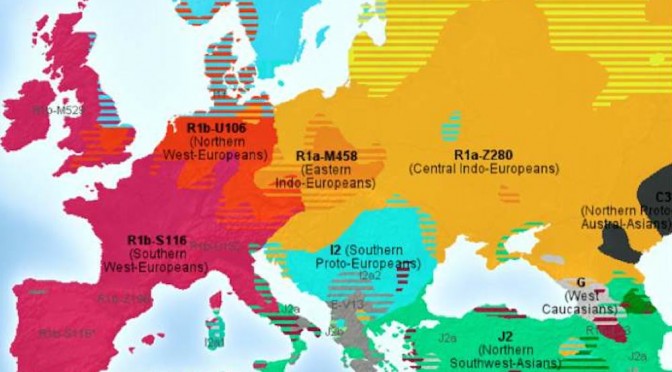If IGENIA is correct, and that may be a big if, then Tutankhamun was part of the same tribe (haplogroup) as the Basques and the Celts. Even if IGENIA has been mislead the difficulty of the Basque language remains. The nearest Language to the Basque Language based on language structure and word associations in Anou The language of Japanese Aboriginals.What circumstances could have lead to the eradication of the Basque language in the lands bordering the northern atlantic or alternatively the introduction of the basque language to the lands bordering the Bay of Biscay and further south?
Long Names
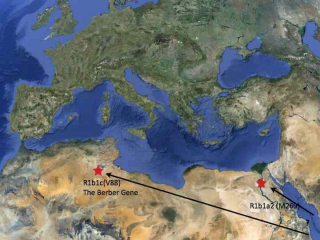 There is an inherent Hierarchical structure in the “long names” for SNP’s which is completely lost if only the “short” names are used. R1b1c (or V88) the North African or “Berber” mutation is a close relation but a totally separate branch to R1b1a2 (M269) which has been identified as Tutankhamun’s DNA.
There is an inherent Hierarchical structure in the “long names” for SNP’s which is completely lost if only the “short” names are used. R1b1c (or V88) the North African or “Berber” mutation is a close relation but a totally separate branch to R1b1a2 (M269) which has been identified as Tutankhamun’s DNA.
If IGENIA is correct, all the European mutations of R1b are subclades of Tutankhamuns R1b1a2.
We do not “know’ where either the R1b1a2 or R1b1c came from, It is possible that both mutations from R1b1 occurred in North Africa though many geneticists favour the Caucusus as the place where the mutation occurred
Troy
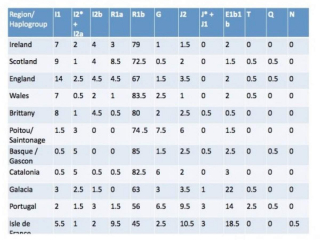 Some people like graphics others prefer numbers. Look at the R1b column to see how R1b dominates.
The key issue is in the Pyrenean counties. Catalonia, Arnagnac, Bearn, Aquitaine, Navarre, Leon and Asturias have all dominant R1b DNA.
The emergent state of Occitan fell within this area.Maps showing only the distribution of R1b with all the subclasses gathered under the same heading are interesting but not helpful in plotting movements.
Some people like graphics others prefer numbers. Look at the R1b column to see how R1b dominates.
The key issue is in the Pyrenean counties. Catalonia, Arnagnac, Bearn, Aquitaine, Navarre, Leon and Asturias have all dominant R1b DNA.
The emergent state of Occitan fell within this area.Maps showing only the distribution of R1b with all the subclasses gathered under the same heading are interesting but not helpful in plotting movements.
The master sub clade for Western Europe R1b1a2a1a1 (L11) is a the third mutation from the DNA possessed by Tutankhamun. R1b1a2a1 (L150) and R1b1a2a1a (L51) precede it.
It is uncertain wether these mutations and L11 itself occurred in Europe or somewhere else. The favoured location for all three is being Anatolia /Armenia. Anatolia is the ancient name for modern Turkey and the home of one of the most famous cities of all time… Troy.
Twin Mutations
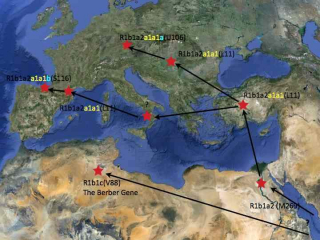 The selection of Anotolia as the location of these most important mutations is based on significant populations of the relevant mutations prevailing through to the present day. Using the same criteria of a lingering presence, L11 then spread (migrated?) in two different ways, firstly to the Pyrenees (Basque country) and secondly and quite separately overland to the Swiss/German borders. The U 106 mutation occurred from basic L11 stock in either The Basque Region or what is now Hungary.
The selection of Anotolia as the location of these most important mutations is based on significant populations of the relevant mutations prevailing through to the present day. Using the same criteria of a lingering presence, L11 then spread (migrated?) in two different ways, firstly to the Pyrenees (Basque country) and secondly and quite separately overland to the Swiss/German borders. The U 106 mutation occurred from basic L11 stock in either The Basque Region or what is now Hungary.
Western Mutations
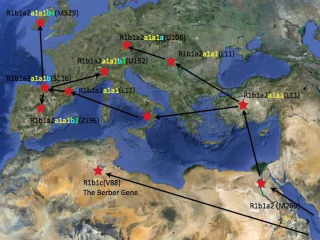 In the basque country L11 then mutated into S116. there were three separate mutations from S116; Z196 which expanded into Spain and North Africa. U152 in Southern France /Northern Italy and M 259 in Ireland
In the basque country L11 then mutated into S116. there were three separate mutations from S116; Z196 which expanded into Spain and North Africa. U152 in Southern France /Northern Italy and M 259 in Ireland
In Central Europe L11 mutated into U106, this was a totally separate mutation but that fact can only be seen by examination of the long names.
The U 106 mutation occurred from basic L11 stock in either The Basque Region or what is now Hungary.
The Celtic Heritage
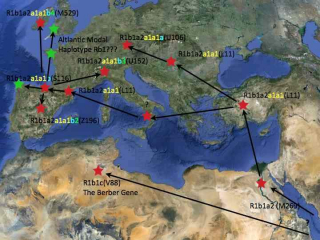 In the British Isles either L11, S116, U152 or U106 mutated into the Atlantic Modal Haplotype (AMH) which until recently was described only by current observable STR’ s. The AMH is apparently now being defined it terms of SNP mutations, in work not yet published. This work will reveal which of the possible preceeding Haplogroups it descended from.
In the British Isles either L11, S116, U152 or U106 mutated into the Atlantic Modal Haplotype (AMH) which until recently was described only by current observable STR’ s. The AMH is apparently now being defined it terms of SNP mutations, in work not yet published. This work will reveal which of the possible preceeding Haplogroups it descended from.
In terms of the Tutankhamun argument the descendacy does not matter but for historians of the Celtic peoples it is vitally important. It could help settle the argument of wether the Celts colonised Europe spreading out from the Atlantic shores or wether they invaded the British Isles from Central Europe.
The Irish M529 is from a quite different branch of the tree than the dominant Atlantic Coastal haplotype which is more common in Brittany, Cornwall and Wales.
in the East
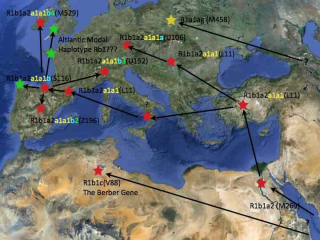 Just to complete the picture, further East on the European Peninsula there was a concentration of R1a, giving a tantalising clue that R1 itself must have its origins further to the east.
Just to complete the picture, further East on the European Peninsula there was a concentration of R1a, giving a tantalising clue that R1 itself must have its origins further to the east.
In summary; The DNA structure shows that the mutation possessed by Tutenkhamun and his immediate ancestors was earlier than the mutations on the Atlantic coast. Peoples must have moved from east to west. We do not know why and it seems likely they took two totally separate routes. It is probable but not certain that U152, thrusting inland from the atlantic coast gave rise to the ” la Tene’ civilisation whereas the U106 derived from the overland migration gave rise to the “Hallstadt” civilisation. This could suggest two groups of “Celts” in Europe who just happened to be lumped together under the same name.
Facing the Ocean
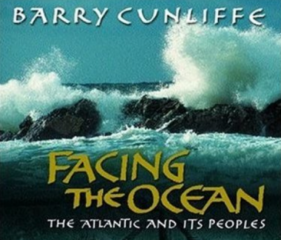 These theories create enormous difficulties for historians of all types. The Basques and early Vascones (Gascons, Armagnacs etc) did not even speak an Indo-European language, which nearly everyone else in Europe , including those called “Celts”, did.
These theories create enormous difficulties for historians of all types. The Basques and early Vascones (Gascons, Armagnacs etc) did not even speak an Indo-European language, which nearly everyone else in Europe , including those called “Celts”, did.
Barry Cunliffe (Sir Barrington Windsor Cunliffe), is an eminent archeologist. In his book “Facing the Ocean” he identifies the people of the Atlantic seaboard as a unique people. In his view, a view based originally on archaeological work, they were independent and clearly differentiated from their inland neighbours.
He proposes that the was a unified Atlantic culture which was concurrent with and not subsequent to either the Halstatt or La Tene cultures, which thrived in Switzerland and Southern Germany. Incidentally these Mid European cultures were not necessarily centred on either Halstatt or La Tene. These are simply the most famous sites which indicated the existence of these cultures.
The Atlantic Peoples
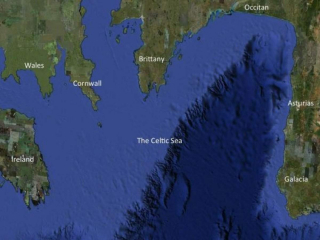
The domain of the Atlantic peoples stretched from the Orkneys to North Africa. The Atlantic peoples included the Basques, and Tartessians and possibly the Iberians and Berbers none of whom spoke Indo- European Languages.For Barry Cunliffe the fact that they are believed to have spoken an Indo Eurpopean language, the ancester of Gaelic, from early times, is a problem.
He sees them as a totally separate people and would have expected them to speak a different language. He proposes that they adopted the Indo European language as a necessity to support their trading activities, in much the same way that English is used throughout much of the world in the twenty-first century.
In other words the Atlantic peoples Originally spoke a non Indo- European language, probably Basque although Barry Cunliffe does not actually as that. Barry Cunliffe came to his conclusions before the most recent DNA studies ( p295 Facing the Ocean 2001) It is interesting that the DNA studies seem to be confirming his instincts.
View from Space
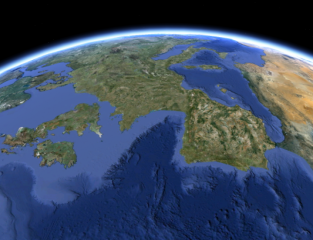 The view from space,over the Atlantic gives quite a different perspective on the Mediterranean from normal projections. Notice how Italy and Greece slope East West . In this view they cease to be a barrier but almost a guide towards the Pyrenees and the Atlantic. It also gives a different impression of the Iberian Peninsula. It looks bulky and so it is. Ninety percent of the peninsula’s land mass is high plain serrated by rivers and mountains.
The view from space,over the Atlantic gives quite a different perspective on the Mediterranean from normal projections. Notice how Italy and Greece slope East West . In this view they cease to be a barrier but almost a guide towards the Pyrenees and the Atlantic. It also gives a different impression of the Iberian Peninsula. It looks bulky and so it is. Ninety percent of the peninsula’s land mass is high plain serrated by rivers and mountains.
Origins
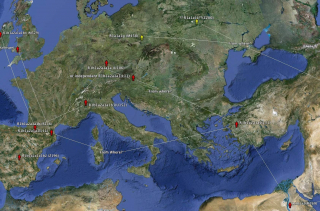 There seems general agreement that before the peoples carrying the R1b mutations settled in the Pyrenees they passed through passed through Anatolia (modern Turkey) but few have speculated on Egypt as a still earlier location.
There seems general agreement that before the peoples carrying the R1b mutations settled in the Pyrenees they passed through passed through Anatolia (modern Turkey) but few have speculated on Egypt as a still earlier location.
Consensus ( that word again) is that it the location for earlier mutations would have been in the Caucasus ( Northern Iran, Armenia), This belief is problematical as the R1a mutation is reputed to have started in exact same location. R1a and R1b however travelled down completely different routes . Now we have this minuscule sample from Egypt. Does it mean anything or nothing?
In the absence of extra information, however. the speculation comes to a grinding halt.
It raises the question however what happened further East?
